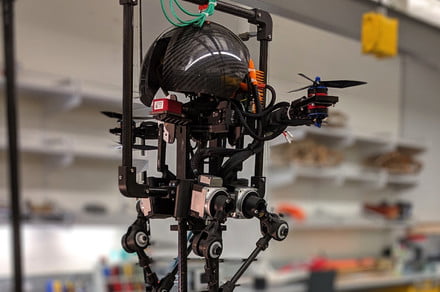[youtube https://www.youtube.com/watch?v=CFM2dRJkkzk?feature=oembed&w=100&h=100]
With their delicate and gangly legs, birds aren’t necessarily the first animal you’d think of when designing a new robot that looks to nature to create effective walking abilities. But birds, with their ability to flap their wings, possess a method of stabilizing themselves that’s not available to many other animals. That’s what researchers from the California Institute of Technology seized upon when developing their new Leonardo robot.
An acronym (well, kind of) derived from “LEg ON Aerial Robotic DrOne,” the lightweight, crane-like Leonardo boasts a pair of thrusters on its body. Although it is perfectly capable of walking on its two legs without help, the thrusters allow it to carry out a kind of locomotion that’s midway between hovering and walking. Should the robot lose its balance, these thrusters help provide the necessary force for it to stay on its feet. They are also capable of making the robot fly short distances while entirely supporting its weight.
While a few robots have explored methods of getting back to their feet once they fall, this is actually a pretty smart approach that could make it easier for robots like Leonardo to be deployed in settings with rougher, more uneven terrains. It’s something that will be particularly useful when it comes to robots used, for instance, in rescue situations, where there’s no guarantee that the surface will be as perfectly flat as it is in a lab setting.
It’s not just rescue operations where Leonardo could prove its value. Caltech has been working with NASA on technologies for future Mars exploration. Leonardo could turn out to be perfect for the job of bipedal exploration robot by being able to float/walk over the red planet’s surface in a way that would challenge many ground-based robots.
Since it’s still currently only usable when tethered, there is clearly a lot more work to be done on this project. However, this is definitely an innovative approach to bipedal robots that takes an unlikely inspiration and turns it into something potentially transformative.
We’re excited to see what Caltech is able to come up with as the next step in the Leonardo project. Hey, a better acronym would be a fine start!
Editors’ Recommendations
- ANYmal dog robot can get back on its feet when someone pushes it over
- Grab a magnifying glass and feast your eyes on the world’s tiniest walking robot
- Watch this weird spider robot perform a crazy aerobics routine
- This unusual nature-inspired robot is equally at home on land or in the water
- Tentacle-like robotic vines exist. We’re not sure if we’re excited or terrified

